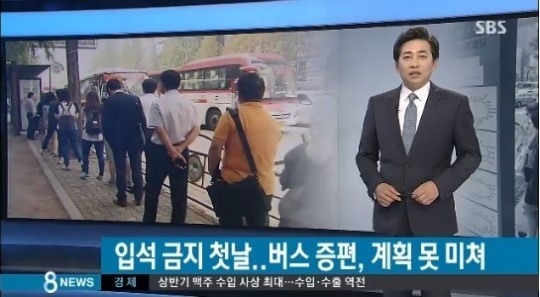
광역버스 입석 금지에 따른 좌석제가 첫 시행된 가운데 승객들의 불만이 이어지고 있다.
16일 경기도와 서울 간 고속화도로를 지나는 직행좌석형(빨간색) 광역버스의 입석 운행이 첫차부터 금지됐다.
도로교통법에 따르면 고속도로나 자동차전용도로를 오가는 차량의 승객은 모두 좌석에 앉아 안전벨트를 매야 한다. 경기도와 인천에서 서울을 오가는 광역버스들의 경우 관행적으로 승객들의 입석 탑승을 허용했지만 승객들의 안전 문제가 대두되면서 광역버스 입석 금지가 실시되는 것.
광역버스 입석 금지로 경기도와 지자체에서는 대안책 마련에 집중하고 있다. 국토교통부와 서울·인천·경기 등 수도권 3개 지자체는 수도권을 오가는 62개 노선에 총 222대의 버스를 투입하기로 했다. 하지만 버스 증차와 운행 횟수 이외의 대안이 없자 승객들은 불편함을 호소하고 있다.
광역버스 입석 금지 소식을 접한 네티즌은 "광역버스 입석 금지, 속 터진다", "광역버스 입석 금지, 대안을 안세우고 무작정 시행하니까 더 위험하다", "광역버스 입석 금지, 결국 택시탔다" "광역버스 입석 금지, 대안 찾는 동안 계속 지각하란 말이냐" 등의 반응을 보였다.
<관련 영문 뉴스>
‘No standing’ policy on intercity buses sparks complaints
The newly imposed “no standing passengers” policy on intercity bus services in the Seoul metropolitan area touched off complaints Wednesday from busy commuters, but stopped short of triggering chaos.
On its first day of implementation, authorities operated over 100 additional buses to make up for the decreased passenger capacity. Despite the effort, a slew of commuters complained of long wait times on their way to work.
Korea’s traffic law states that all passengers aboard vehicles on freeways must be seated.
Due to the large number of commuters in Seoul, Incheon and Gyeonggi Province, however, intercity buses in these areas that take freeways customarily allowed standing passengers. This sparked a safety concern for the passengers.
Last month, the Ministry of Land, Infrastructure and Transport banned the intercity buses from taking standing passengers.
A 28-year-old office worker named Lee, who commutes to central Seoul from Suwon, Gyeonggi Province, said she waited 30 minutes before being able to board the bus.
“I ended up walking two stops away from my usual stop to board the bus. The authorities cannot possibly expect this to work,” she said.
According to the Transport Ministry, about 110,000 commuters take the bus from 6:00 a.m. to 9:00 a.m., 15,000 of whom are standing passengers.
Because these buses can carry between 40 and 45 passengers, the government needs over 300 additional vehicles to make up for the shortage of passenger capacity.
Local media reports showed several intercity buses allowing standing passengers despite the government ban.
In addition to commuter discontent, bus companies are complaining of the drop in profits due to the decreased capacity.
While citizens complained of the prolonged commute time, officials from Gyeonggi Province said that the new system is being conducted smoothly.
But experts are saying that the authorities must prepare to augment the system, as the summer vacation season is keeping the number of intercity commuters relatively low.
By Yoon Min-sik (minsikyoon@heraldcorp.com)



![[Exclusive] Korean military set to ban iPhones over 'security' concerns](http://res.heraldm.com/phpwas/restmb_idxmake.php?idx=644&simg=/content/image/2024/04/23/20240423050599_0.jpg&u=20240423183955)

![[Graphic News] 77% of young Koreans still financially dependent](http://res.heraldm.com/phpwas/restmb_idxmake.php?idx=644&simg=/content/image/2024/04/22/20240422050762_0.gif&u=)



![[Pressure points] Leggings in public: Fashion statement or social faux pas?](http://res.heraldm.com/phpwas/restmb_idxmake.php?idx=644&simg=/content/image/2024/04/23/20240423050669_0.jpg&u=)









